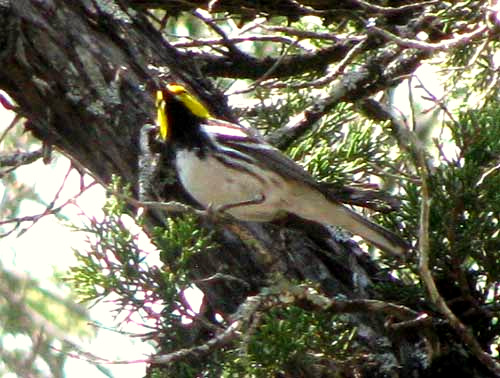Excerpts from Jim Conrad's
Naturalist Newsletter
from the March 24, 2013 Newsletter issued from the valley of the Dry Frio River in northern Uvalde County, southwestern Texas, on the southern border of the Edwards Plateau; elevation ~1750m (~5750 ft); N29.62°, W99.86°; USA
GOLDEN-CHEEKED WARBLER
About mid slope on the limestone hill to the east I heard the call of what seemed to be a migrating Black-throated Green Warbler, but the call was a variation I'd never heard before. I've heard lots of Black-throated Greens singing as they passed through the eastern US between their nesting grounds in North America's northern coniferous forests and their overwintering area in Mexico, Central America and northern South America. Often during migration they're the main bird you hear, the typical song sounding something like zoo-zee, zoo-zoo-zee, repeated again and again, and there might be so many of the calls coming from all different directions that it can be funny to hear.
But, this call was the most extreme variation on the Black-throated Green Warbler theme I'd ever heard. In fact, it was so unusual that I wanted to see this bird, just to be sure my mind wasn't playing tricks. And I did see him, just for an instant when he flew into an Ashe Juniper not far away, as witnessed below:

That bird certainly has the Black-throated's black throat, the yellow cheeks and white wingbars but, still, I decided to check to see if there were other closely related species in this area that might have a different call. And there was:
The Golden-cheeked Warbler, DENDROICA CHRYSOPARIA, is almost identical to the Black-throated Green Warbler, except that its back is black instead of olive green, the lines passing through its eyes are blacker, its song is similar but clearly different and... it's an officially endangered species, both in the US and on the IUCN Red List. Golden-cheeked Warblers nest only in central Texas's mixed Ashe Juniper and oak woodlands, in ravines and canyons -- in the whole world only in our little area -- where they feed on insects and spiders on tree leaves and bark.
The IUCN page for the species says that " ...the population was estimated to number 21,000 individuals in 2004... There was a 25% loss in available territories between 1962 and 1981 ..., and the population has clearly declined. It winters in southern Mexico (Chiapas), Guatemala, El Salvador, Nicaragua, and Honduras... " The IUCN Red List for the Golden-cheeked Warbler is at http://www.iucnredlist.org/details/106009107/0.
I sent our picture to my old birding buddy Jarvis, who has a PhD in bird ecology, and he thinks our bird probably is indeed the Golden-cheeked Warbler, not only because we're exactly where the bird should be right now, in the exact habitat, and because the song I heard was like the Black-throated Green's song but not quite, but also because the black line barely detectable in our bird's picture is about right for the Golden-cheeked, and too dark for the Black-throated. Also, now that I've compared our bird with many pictures, it seems to me that the blackness of our bird's throat extends over the front of the shoulder in a way it doesn't on the black-throated Green. I just wish I could have seen that black back!